Only those who have ever had olive oil under their nose and in their mouth can know what good olive oil tastes like... Unfortunately, these connoisseurs are a minority among olive oil consumers. Since full-flavoured, pure olive oil is still rare and bad goods are not only capillary but also accessible to everyone in terms of price, their bad flavours are commonly understood as "typical". This often leads to the point that really good olive oils, which have fresh olive aromas, a certain bitterness and above all the characteristic pungency, are rejected.
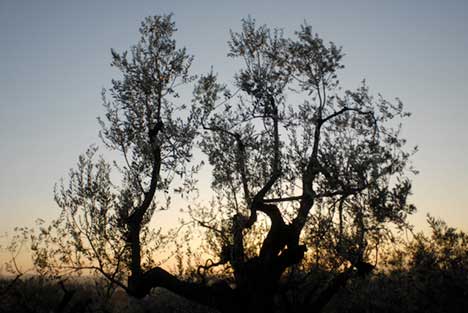 |
| Even if olive oil did not taste so good% even if it was not so good for health% olive trees should be planted for their beauty. The sight of them is a treat for the eye and medicine for the soul |
Quality can be perceived subjectively in very different ways. Those who are used to tasteless things will be disturbed by tasty things. Those who are used to strong smells and flavours will not appreciate subtleties. To those who know only flawed things, a clean taste will seem bland. And those who have never enjoyed a good olive oil will be shocked by its bitterness and pungency.
But beware: whether an olive oil is good or faulty (in other words, extra virgin or not) is not a matter of taste, but an objectively ascertainable fact. It takes a certain amount of experience to be able to distinguish a faultless oil (extra virgin) from a faulty one (virgin or lampante).
There is an essential difference between the tasting of olive oil by a panel (group of tasters) and wine tasting: while wine tasting is always subjective and is concerned with how much enjoyment value the tasters attribute to a wine, the panel is concerned with the classification of oils based on the presence or absence of negative characteristics. Panels are required to be able to confidently classify an oil based on sensory impressions. Personal preferences are not allowed to play a role for panel members.
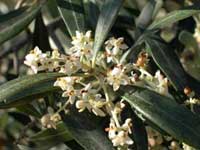 |
| From this work of art ... with hundreds of blossoms, a few olives emerge. Most of the blossoms fall off% as soon as the splendour is over. The olive tree is very capricious and decides very arbitrarily% how many fruits it wants to bear |
It is a matter of taste, however, whether we prefer a faultless oil from Tuscany to a faultless oil from Crete, a faultless oil from the Marche to a faultless oil from Andalusia. Only when it has been established that an oil is sensorially flawless may subjectivity begin!
Quality is also an issue for the law. It defines different quality categories, which are defined by a whole series of chemical limits and have to pass a panel test. The production regulations of the PDO olive oils also make use of analytical limit values to make the minimum quality and authenticity of the olive oils controllable.
How extra virgin must taste
A good extra virgin is characterised by extreme freshness, in colour, in the nose, on the palate. Olive oil should not be too viscous, but rather thin. Yellow, dull, thick oils are already repulsive in appearance and never taste good. Olive oil can be deep green, light green, green-yellow or golden yellow with a fine green shimmer, the only important thing is that it shines. When poured onto a white plate or a slice of bread, it should seduce you, not repel you. Dark yellow colour indicates advanced oxidation.
The colour of olive oil is insignificant for the official classification and is not taken into account, but for the consumer the appearance plays the same role as for wine. Straw-yellow, viscous oils are far less appetising than green or golden-green olive oils.
One can assume that olive oils with green reflections taste more olive-fruity than yellow oils. However, the assertion that the green colour of some quality oils comes from the co-grinding of the olive leaves shows a lack of expertise. The green colour of olive oils comes from the processing of green, still unripe fruits - unless counterfeiters were at work. Black, overripe olives or olives that have fallen into nets or on the ground result in yellow, sweetish oils without a distinct fruit.
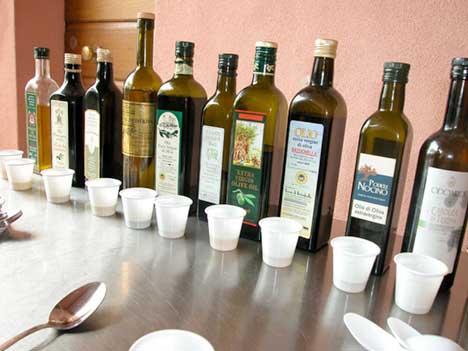 |
| Connoisseurs taste olive oils like wine |
Freshness on the nose is the first quality criterion. Green aromas like freshly cut grass, unripe olives, artichokes, green tomatoes indicate healthy olives that were harvested at the right moment, not too unripe and not too ripe. Overripe olives, but also oxidative treatment in the oil mill and during storage, give notes reminiscent of almonds, hazelnuts and butter. Injured, rotten, pest-infested olives lying around for several days as well as improper treatment of the olive paste in the oil mill result in oils with off-flavours. On the palate, the freshness of the aromas must be confirmed. Not all fruit aromas are welcome, for example sweet aromas of ripe banana or apple as well as cooked vegetables indicate improper treatment of the olives or the olive pulp.
Flavour harmony is welcome in a good olive oil, bitterness is an indispensable quality characteristic but should not stand out and hinder the perception of the fruit. Nevertheless, an extra virgin that does not have a noticeable bitterness and does not taste clearly pungent will receive deductions in the tasting.
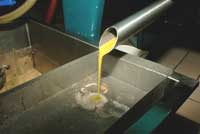 The more the aromas and the taste of an olive oil are reminiscent of the fresh olive, the more clearly the varieties and the region of origin can be tasted, the more valuable an extra virgin is. Five years ago, Merum said: "In the future, we will see competitions where extra virgin olive oils from Sicily and Sardinia will compete with those from Tuscany and Marche for the title of the best olive oil. Classifications will be published where specialised oil journalists will describe and evaluate hundreds of oils..." This future is already present, interest in oil is increasing at a rate that was pure vision just a few years ago.
The more the aromas and the taste of an olive oil are reminiscent of the fresh olive, the more clearly the varieties and the region of origin can be tasted, the more valuable an extra virgin is. Five years ago, Merum said: "In the future, we will see competitions where extra virgin olive oils from Sicily and Sardinia will compete with those from Tuscany and Marche for the title of the best olive oil. Classifications will be published where specialised oil journalists will describe and evaluate hundreds of oils..." This future is already present, interest in oil is increasing at a rate that was pure vision just a few years ago.
The more we know about olive oil, the more image individual oil producers can create thanks to the quality of their oil, the less consumers will have to orientate themselves on the presentation of the bottle and the price. However, today we are only at the very beginning of the new olive oil high culture, perfect olive oils are still rare, too many oil mills still work poorly, we all still understand too little about the juice of the olive, the offer is still dominated by identity-less industrial products, superficial presentation and misleading labelling, but also by defective producer oils.
Due to the capillary spread of cheap oils and the rarity of quality oils, broad consumer strata have become accustomed to false flavours instead of the scent of fresh olives and the characteristic bitterness and pungency of genuine extra virgin. People have imprinted on their minds as "typical" a taste that is due to advanced spoilage of the olives and rancidity.
The fruitiness of the olive is alien to them and they reject the bitterness and pungency as signs of spoilage. The qualitative heterogeneity of the olive oils on offer is still too confusing for the consumer, who finds excellent olive oils next to products with an uninteresting taste on the same shelf. However, the designations of origin protected by the EU, the work of some authors, rapidly growing quality ambition among oil producers and ever more diligently organised tastings at professional and consumer level will rapidly advance the culture of olive oil in the coming years.
Quality is ..
... a modern invention
Olive oil has been an important source of fat in the Mediterranean for 6000 years. Until late in the 20th century, olive oil was used not only for skin care, wound healing and nutrition, but also as lamp oil and a source of heat. Excavations on Cyprus have shown that a good 4000 years ago copper was extracted with the help of olive oil-fuelled fire. With the oil, a temperature of more than a thousand degrees could be reached in the forge. Moreover, olives have always been an important food and oil an excellent source of energy. But just as most wine was consumed as vinegar back then, oil was quite malodorous.
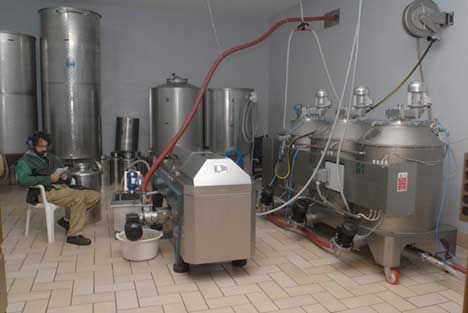 |
| Oil mill romance is no guarantee of quality. If you want to make top-quality oil% you have to rely on state-of-the-art technology: The picture shows a small-scale plant with closed kneading units under a light vacuum and a two-phase decanter |
There are actually authors who glorify ancient Roman times and claim that olive oil was better then than it is today. Anyone who knows even a little about biochemistry and food technology rules out the possibility that the methods available at the time produced something delicious. It is possible that the oil from the first, cold pressing - at that time several passes were necessary to press all the oil out of the pulp - was actually edible and comparable to the quality of the production of oil mills with millstones and hydraulic presses.
 However, the oils obtained with the old methods were exposed to strong air contact and thus their shelf life was strongly impaired. What ran out of the press during further pressing and was rinsed out with hot water at the end was no delicacy. But nevertheless, this oil saved us from hunger and darkness. Notes of artichokes, fresh almonds and tomato leaves were not associated with olive oil until a few years ago. The demand for quality in olive oil is a typical phenomenon of our affluent society. Just like we no longer like wines with acetic souring.
However, the oils obtained with the old methods were exposed to strong air contact and thus their shelf life was strongly impaired. What ran out of the press during further pressing and was rinsed out with hot water at the end was no delicacy. But nevertheless, this oil saved us from hunger and darkness. Notes of artichokes, fresh almonds and tomato leaves were not associated with olive oil until a few years ago. The demand for quality in olive oil is a typical phenomenon of our affluent society. Just like we no longer like wines with acetic souring.
Obstacle to quality: wrong traditions
Tradition can be wealth. To insist on bad traditions, however, is to miss out on progress. Bad traditions in harvesting and processing are a persistent problem, especially in old production areas. While the new olive oil producers overseas always use the freshest knowledge and the most modern technology for cultivation and extraction, in the classic production areas people excuse bad backwardness with tradition.
In two different German TV reports, viewers could recently admire footage from old oil mills. Close-ups showed how a dark brown, oily liquid came out of press mats. It is perfectly understandable that such disgusting images disgust squeamish viewers. Unfortunately, these images of obsolete oil mills are not from a culinary horror film, but from reality.
And instead of the people in charge of such oil mills forbidding the dissemination of such images, they are - one may assume - proud of them. They are not in the least aware that in their oil mill most of what makes olive oil valuable from a culinary and health point of view is destroyed.
In order to produce a genuine extra virgin olive oil without any notes of oxidation and stinginess, conditions are required that are fulfilled by very few farms today. It may surprise 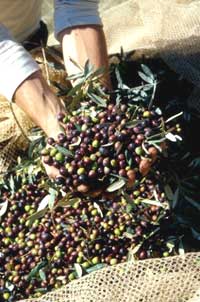 that only a minority of olive producers know that olives are as perishable and delicate as grapes and should be treated no less gently.
that only a minority of olive producers know that olives are as perishable and delicate as grapes and should be treated no less gently.
Olives that are carefully harvested and processed in the oil mill within a few hours - i.e. before the first signs of decomposition become apparent - are the exception. Furthermore, only a minority of oil millers are interested in the fact that the olive paste they process is a biochemically highly reactive substance that can spoil in a matter of minutes. Even from fresh olives, most oil mills are pressing defective oil. The majority of oil mills are not capable of producing high-quality olive oils in terms of technical equipment and their organisation.
Olive pulp and cloudy olive oil are extremely sensitive substances that not only absorb all foreign flavours but also decompose rapidly under the influence of air and heat. Oil extraction with hydraulic presses and press mats may correspond to an ancient tradition, but it is completely outdated for hygienic and qualitative reasons.
Another wrong tradition is the bad habit of bottling olive oil unfiltered. Some producers even go so far as to write "unfiltered" on the oil bottles. Any chemical laboratory technician could explain to the producers the destructive effects of turbidity on the quality of the oil.
An argument often heard in this regard is that of naturalness: "Cloudy oils are more natural than filtered ones." This is true. But it is equally true that grapes rotting on the ground are more natural than wine, brown, fermenting olive pulp more natural than white, protected by enzymatic actions... and rancid, degraded oil more natural than fresh.
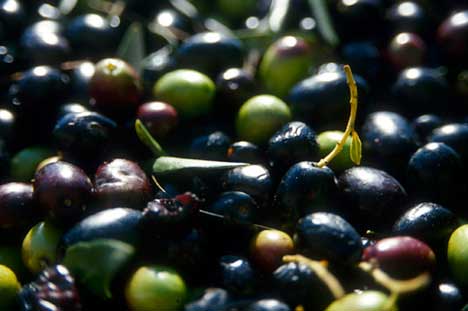 |
| Bad traditions in harvesting and processing are a persistent problem, especially in old production areas. |
Spoilage is a natural process! Only: Food is created by controlling natural processes in favour of flavour and nutritional value. In the extraction of oil from olives, man can intervene at various moments with artificial tricks to obtain oil with as much and as untainted natural substances as possible. There is no question that the quality of olive oil in general needs to be improved. Just as has happened with wine: wine quality has also experienced an enormous increase over the past thirty years as a result of rising consumer demands. But it is also clear that the large masses of oil cannot remain unsold, even if they are of inferior quality. For large production areas in Spain, Greece and southern Italy, this would be a disaster.
Oils with minor defects (virgin or vergine) do have their uses. Even if gourmets ignore them, these oils have their health benefits and are also affordable for people who are convinced of the Mediterranean diet but whose household budget does not allow for the regular purchase of top-quality oils.The representatives of the olive oil category are incomparably less interesting in terms of health and taste. Apart from the fatty acids, refining leaves nothing of the positive properties of the oil of the olive. For this reason alone, everything must be done to reduce the production of lampante olive oil. However, as long as low-quality olive oil is allowed to be marketed at ridiculous prices as extra virgin, the production of the large masses will not get off the ground in terms of quality.
 As suppliers to the oil industry, most producers are dependent on market prices. The production costs of olives for extra virgin are incomparably higher than those for lampante olive oil. However, since the price paid to producers is practically the same for the two qualities, they tend to keep the cost as low as possible: Instead of olives freshly picked from the tree, they will continue to bring overripe and rotten olives that have fallen to the ground to the oil mill.
As suppliers to the oil industry, most producers are dependent on market prices. The production costs of olives for extra virgin are incomparably higher than those for lampante olive oil. However, since the price paid to producers is practically the same for the two qualities, they tend to keep the cost as low as possible: Instead of olives freshly picked from the tree, they will continue to bring overripe and rotten olives that have fallen to the ground to the oil mill.
Unfortunately, not only the quality of cheap discount olive oils is poor, but also the oils of agricultural self-marketers are often unsatisfactory. Even indignant producer pride does not change this! The flooding of the market with cheap extra virgin paralyses the quality development of the whole sector.
Sign of quality: a scratchy throat
At the end of 2005, the following dpa report circulated on the internet: "Good olive oil must not scratch your throat." This sentence comes from Bernhard Watzl of the Institute for Nutritional Physiology at the Federal Research Centre for Nutrition and Food (BfEL) in Karlsruhe. "Scratching indicates a high content of free fatty acids." If a private person had spread this misinformation, the matter could have been forgotten with an annoyed shake of the head. After all, one cannot react to every nonsense. However, since Dr. Bernhard Watzl is considered one of the most renowned researchers in the field of secondary plant compounds and is head of the Institute for Nutritional Physiology at the Federal Research Centre for Nutrition in Karlsruhe, the Merum editorial team felt morally obliged to contradict him.
In issue 6/2005, Merum published a dispute between Prof. Watzl and Andreas März, in which the Merum editor asked the nutrition expert for a rebuttal. The researcher, however, insisted on his negative attitude towards oils with a scratchy finish.
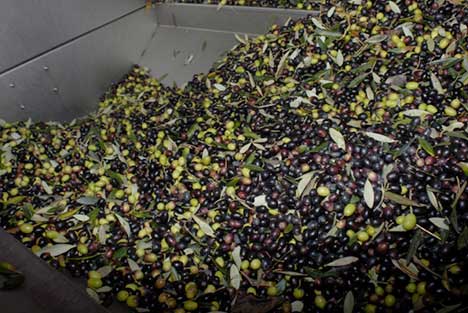 |
| Green and black olives often hang on the same tree. The right time to harvest is not determined by colour% but by chemical analysis: the sugar content in the olives and the enzymatic activity should be low. |
However, the scratchy throat is not a matter of personal taste, but an important quality characteristic of extra virgin, which is even required by law. Genuine, high-quality olive oil is not only fruity, but always bitter and pungent. EU Regulation 796 of 2002 stipulates only the three mentioned as positive sensory characteristics:
There are many consumers outside the producing countries who find pungency in an oil annoying. But that is not a problem, there are plenty of other fats that taste mild: refined vegetable oils, butter, refined olive oil, lard etc... But genuine extra virgin is not one of the mild tasting fats, extra virgin definitely scratches! If you don't like an oil that itches your throat and is slightly bitter, you can't claim to like extra virgin ..
Perhaps some consumers who are not used to olive oil prefer milder oils with lower polyphenol content. They stick best to older oils or those obtained by traditional methods (millstones and press). The mildness and more or less pronounced oxidation notes bring these oils closer in taste to fats common in the north.
Important quality feature: antioxidants
How should we recognise the quality of an oil? The good and independent taster says, "I'll tell you if it's a good oil or not." The bad - or independent - taster repeats him and 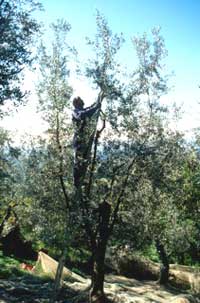 awards prizes to discount oils for some magazine. No, unfortunately, you can't rely on tasters. Who can say which ones we can trust and which ones we can't?
awards prizes to discount oils for some magazine. No, unfortunately, you can't rely on tasters. Who can say which ones we can trust and which ones we can't?
We need objective, repeatable quality parameters that can be determined with machines and laboratory equipment: Two dozen minimum and maximum values are already laid down in the law. Unfortunately, these limits are no longer of much use because the adulterators work so well that the control laboratories are not able to distinguish genuine from adulterated oils with these values.
A high-quality virgin olive oil, an extra virgin in the true sense of the word, has intact triglycerides (= fats), so it suffers neither from split-off "free" fatty acids nor from oxidative corrosion. A top oil also has a high content of secondary plant substances, which make up one to two percent by weight.
Among these non-fatty substances are several health-promoting, antioxidant substances, with polyphenols certainly being the most important fraction. These bitter to pungent tasting substances protect the oil from oxidative spoilage, rancidity, and us humans from disease-causing free radicals.
The total content of polyphenols depends on the variety, the origin, the climate, the time of harvest, the harvesting method and the extraction method. Since these polyphenols protect the oil from oxidation by sacrificing themselves and allowing the oxygen atoms to oxidise them, their quality drops rapidly if they are poorly processed.
The fat-soluble polyphenols of olive oil are the cleavage products of the water-soluble glycosides, i.e. the polyphenols oleuropein and ligstroside bound to sugar molecules in the olive. Only the contact with air during the injury of the olives and during the milling process allows the enzyme beta-glucosidase present in the olive to split off the sugar molecule and to convert oleuropein and ligstroside into fat-soluble forms. These original polyphenols have high molecular weights and are further broken down by hydrolytic processes (in the presence of water) into polyphenols of medium and later low molecular weight or degraded by oxidation.
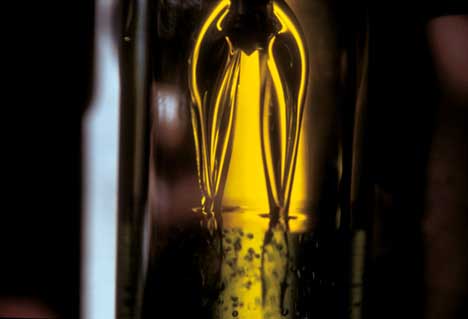 |
| Olive oil during bottling. How good it is% is decided above all by the polyphenol content. |
The hydrolytic degradation of polyphenols takes place in the presence of water. If the first stage of degradation can already take place in stored, injured olives and the olive pulp in the agitators, the breakdown of the polyphenols takes place afterwards in the cloudy oil.
For this reason alone, olive oil should be filtered as soon as possible after pressing and thus freed from the fine water droplets. Even if the chemical analysis of young olive oils does not reveal any major differences between filtered and unfiltered oils, the situation changes rapidly in the course of the months after the harvest.
The higher the content of medium and high molecular weight polyphenols (oleuropein and ligstroside forms), the more potent the antioxidant effect of an oil, the healthier and more durable it is, but also more bitter and pungent.
Peak polyphenol values are between 500 and 800 mg/kg, values from 250 mg/kg are good. Low molecular weight polyphenols (tyrosol and hydroxytyrosol) are still useful, but they represent the last hydrolytic degradation stage and are far less valuable than the denser fractions. A fairly good example would therefore be 210/300 mg/kg, bad: 35/90 mg/kg, peak: 583/733.
The good taster can feel both the content and the quality of the polyphenols on his palate: mild oils tend to have a lower polyphenol content with a high proportion of fractions of low molecular weight, bitter and pungent oils on the other hand are rich in polyphenols, usually with a high proportion of fractions of medium and higher molecular weight.
The analysis of the individual polyphenol fractions gives clear indications of the health status of an olive oil. At the same time, this analysis also provides information about the health value of an oil.
With the HPLC method (High Performance Liquid Chromatography), the individual polyphenols can be determined in terms of quantity. Although the quality of an extra virgin oil could be determined beyond doubt by means of these contents, there is still no officially recognised standard method for the HPLC determination of polyphenols.
It cannot be a coincidence that the polyphenol method, which can be used to distinguish high-quality from low-quality oils, has never been developed by the EU as an official test method!